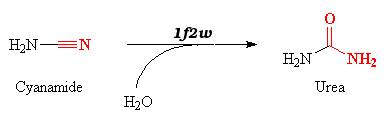Sandbox Reserved 964
From Proteopedia
(Difference between revisions)
| Line 9: | Line 9: | ||
This enzyme is a lyase, which is able to break C-N links, and needs its cofactor, the zinc ion, to be activated. | This enzyme is a lyase, which is able to break C-N links, and needs its cofactor, the zinc ion, to be activated. | ||
| - | Carbonic anhydrase II is located in the cytosol, and normally catalyzes the reversible hydration of CO2 into bicarbonate | + | Carbonic anhydrase II is located in the cytosol, and normally catalyzes the reversible hydration of CO2 into bicarbonate: |
| - | + | [[Image:D7423ca6daa1149f361c10b977acad36.png]] | |
| + | |||
| + | |||
| + | But in this representation, we observe the carbonic anhydrase II bound to its suicide substrate, the cyanamide, which is hydrated by the enzyme, forming urea. The urea-carbonic anhydrase II complex leads to the inactivation of the enzyme. | ||
| + | |||
| + | Cyanamide is an organic compound, which formula is : | ||
| + | |||
| + | [[Image:620px-Cyanamide.svg.png|300px]] | ||
==Structure== | ==Structure== | ||
| Line 29: | Line 36: | ||
| - | There | + | There are two binding sites for mercury : |
- <scene name='60/604483/Hg_binding_site/1'>Hg binding site</scene>. | - <scene name='60/604483/Hg_binding_site/1'>Hg binding site</scene>. | ||
| Line 51: | Line 58: | ||
[[Image:Cyanamide.png]] | [[Image:Cyanamide.png]] | ||
| - | Cyanamide is a toxic compound, and is an analog of CO2. It can thereby bind the active site of the carbonic anhydrase. | + | Cyanamide is a toxic compound, and is an analog of CO2. It can thereby bind the active site of the carbonic anhydrase II. |
The reaction is a '''suicide inhibition''': the enzyme binds an suicide substrate (here cyanamide), and this substrate is modified by the enzyme (here into urea) and produces a reactive group that forms a '''stable inhibitor-enzyme complex'''. | The reaction is a '''suicide inhibition''': the enzyme binds an suicide substrate (here cyanamide), and this substrate is modified by the enzyme (here into urea) and produces a reactive group that forms a '''stable inhibitor-enzyme complex'''. | ||
| + | |||
| + | The inactivation of the carbonic anhydrase II leads to health problems. In fact, it can cause several diseases, such as osteopetrosis autosomal recessive type 3 (also known as Guibaud-Vainsel syndrome). This syndrome is associated with renal tubular acidosis, cerebral calcification (marble brain disease) and in some cases with mental retardation. | ||
==Mechanism of Action== | ==Mechanism of Action== | ||
| Line 60: | Line 69: | ||
Urea is tightly linked to the carbonic anhydrase II, acting in this way as an inhibitor. | Urea is tightly linked to the carbonic anhydrase II, acting in this way as an inhibitor. | ||
| - | |||
| - | |||
| - | == Disease == | ||
| - | |||
| - | Defects in CA2 are the cause of osteopetrosis autosomal recessive type 3 (OPTB3) [MIM:259730]; also known as osteopetrosis with renal tubular acidosis, carbonic anhydrase II deficiency syndrome, Guibaud-Vainsel syndrome or marble brain disease. Osteopetrosis is a rare genetic disease characterized by abnormally dense bone, due to defective resorption of immature bone. The disorder occurs in two forms: a severe autosomal recessive form occurring in utero, infancy, or childhood, and a benign autosomal dominant form occurring in adolescence or adulthood. Autosomal recessive osteopetrosis is usually associated with normal or elevated amount of non-functional osteoclasts. OPTB3 is associated with renal tubular acidosis, cerebral calcification (marble brain disease) and in some cases with mental retardation.[1] [2] [3] [4] [5] | ||
Revision as of 20:08, 8 January 2015
| This Sandbox is Reserved from 15/11/2014, through 15/05/2015 for use in the course "Biomolecule" taught by Bruno Kieffer at the Strasbourg University. This reservation includes Sandbox Reserved 951 through Sandbox Reserved 975. |
To get started:
More help: Help:Editing |
1f2w: Carbonic Anhydrase II
| |||||||||||



